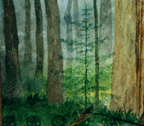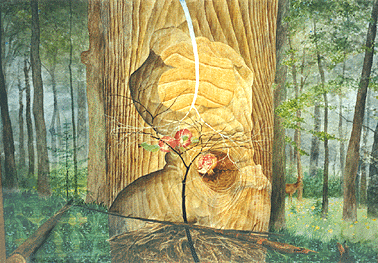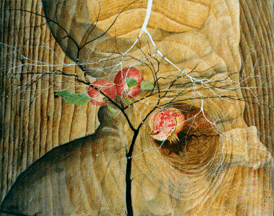

FROM ANTON KRAJNC'S "COMPLETED PROJECTS":
"AXIS MUNDI"

"Nel mezzo del cammin' di nostra vita
mi ritrovai per una selva oscura,
che la diritta via era smarrita..."

("In the middle of the path of our life
I found myself in a dark forest,
having lost the way...")
DANTE ALIGHIERI
(Opening line of the "Divina Commedia")

In religions and myhtologies around the globe
there is talk of a giant tree, growing from
the "middle of the world" (axis mundi).
It is the Tree of Life.
Planted in the middle of these woods, the tree
becomes the path itself, leading out of the very forest,
through life and death, winter and spring, part of
the eternal circle, in which all living things move.
The forest may be dark, but it is not threatening:
light filters through the trees, signals solution, salvation.
A deer is looking at the human standing in front of the painting.
Alert. Fearless. Drawing him/her through eye contact
into the scene.

The man's torso, carved from the tree,
has a triple meaning/personality:
he is Christ
(who had to die on the cross - synonym of the tree,
the wood - to gain eternal life);
he is the God Dyonysios
(of whom it is said that he lives in trees
and makes them bear fruit -
he, too, had to die, to be reborn immortal);
and he is Man
(who is linked to all other living things through nature).

A slender, black tree reaches for
its white upside down counterpart - yin and yang?
The branches intertwine.
Where they touch, they ignite golden sparks.
The upside-down tree, also part of our universal symbolism,
unites Heaven and Earth, brings wisdom and illumination,
drawing them down to us with its roots.
Dante talks about this tree in the part "Paradiso"
of his epic poem "Divina Commedia".

"AXIS MUNDI":
105cm x 71cm
egg tempera, watercolor, pen and ink and gold leaf on Arches paper
(one of five works in a series on the theme of THE DARK FOREST.)


PORTFOLIO

BACK TO "SELVA"

Last modified: Apil 9, 2012
Copyright© 1997-2012 by Anton Krajnc. In keeping with the spirit of the Internet,
all images are for personal, non-commercial use only.
STRONG>Photography by Anton Krajnc and Dagmar.
All artwork and text information contained on these pages is original, and is protected by copyright and trademark laws.
For questions or information regarding the use or licensing of text, artwork or other contents, please contact the artist
via email: akstudio@flash.net.





